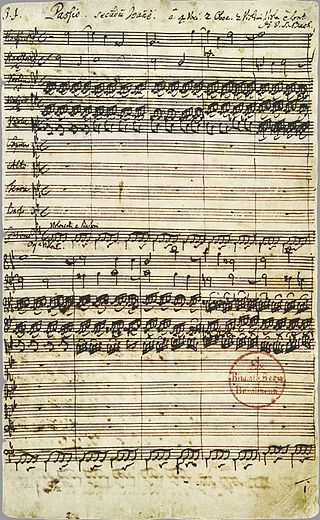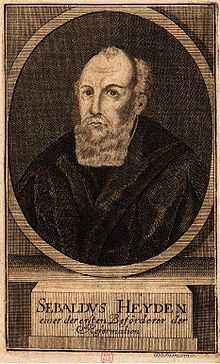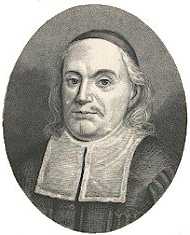St John Passion structure
| St John Passion | |
|---|---|
| BWV 245 | |
| Passion by J. S. Bach | |
|
First page of the autograph | |
| Original | Paßio secundum Joannem (Passion after John) |
| Occasion | Good Friday |
| Performed | |
| Movements | 40 in two parts (14 and 26) |
| Text | anonymous |
| Bible text | John 18–19 |
| Chorale | stanzas from 9 chorales (version 1) |
| Vocal | SATB choir and solo |
| Instrumental |
|
The structure of the St John Passion (German: Johannes-Passion), BWV 245, a sacred oratorio by Johann Sebastian Bach, is "carefully designed with a great deal of musico-theological intent".[1] Some main aspects of the structure are shown in tables below.
The original Latin title Paßio secundum Joannem translates to "The Passion after John". Bach's large choral composition in two parts on German text, written to be performed in a Lutheran service on Good Friday, is based on the Passion, as told in two chapters from the Gospel of John (John 18 and John 19) in the translation by Martin Luther, with two short interpolations from the Gospel of Matthew. During the vespers service, the two parts of the work were performed before and after the sermon. Part I covers the events until Peter's denial of Jesus, Part II concludes with the burial of Jesus. The Bible text is reflected in contemporary poetry and in chorales that often end a "scene" of the narration, similar to the way a chorale ends most Bach cantatas. An anonymous poet supplied a few texts himself, quoted from other Passion texts and inserted chorales by nine hymnwriters. Bach led the first performance on 7 April 1724 in Leipzig's Nikolaikirche. He repeated it several times between 1724 and 1749, experimenting with different movements and changes to others, which resulted in four versions. The Passion, close to Bach's heart, has an "immediate dramatic quality".[2]
Structure
Text
Gospel
The gospel account by John narrates the story in five "scenes". The corresponding movement numbers are given from the Neue Bach-Ausgabe (NBA).
Part I
- Arrest (1–5), Kidron Valley (John 18:1–11)
- Denial (6–14), palace of the high priest Kaiphas (John 18:12–27)
Part II
- Court hearing with Pontius Pilate (15–26) (John 18:28–40 and John 19:1–22)
- Crucifixion and death (27–37), Golgatha (John 19:23–30)
- Burial (38–40), burial site (John 19:31–42)
Some musicologists regard movement 24 as the conclusion of scene 3, the aria "Eilt, ihr angefocht'nen Seelen" which locates the action from the courthouse to Golgotha, the calvary.[3] Others, including Alfred Dürr regard the scene as ending with the last comment by Pilate.[4]
Bach incorporated two short interpolations from the Gospel of Matthew, Matthew 26:75 after John 18:27, describing the weeping of Peter, and Matthew 27:51–52 after John 19:30, describing the tearing of the temple curtain. The narrator is the Evangelist, a tenor, Jesus and all other male characters are sung by a bass, the people who are often summarily called die Jüden (the Jews) are sung by a four-part chorus (SATB) in dramatic turba movements. The "immediate, dramatic quality" of the "kind of musical equivalent of the Passion Play" relies on the setting of the interaction between the historical persons (Jesus, Pilate, Peter) and the crowd ("soldiers, priests, and populace").[2]
Chorales
At eleven points in the structure, chorales reflect the narration, stanzas from Lutheran hymns. Possibly Bach had an influence on their selection.[5] He set them all in common time for four parts, the instruments playing with the voices.
Five chorales conclude a scene (in movements 5, 14, 26, 37 and 40), a chorale opens Part II (15). Five chorales comment within a scene (3, 11, 17, 22, 28). including the central movement of the whole Passion (22). One chorale accompanies the bass soloist in an aria (32).
Most chorale texts were written in the 16th and 17th century,[6] by authors of the Reformation such as Martin Luther, Martin Schalling and Michael Weiße, and by hymn writers including Paul Gerhardt and Johann Heermann. The central chorale is not part of a common hymn.
Contemporary text
On a third level of text, contemporary poetry reflects the biblical narration. It was compiled by an unknown author, who partly used existing text. From the Brockes Passion (Der für die Sünde der Welt Gemarterte und Sterbende Jesus, aus den IV Evangelisten, Hamburg, 1712 and 1715) by Barthold Heinrich Brockes, he copied for movements 7, 19, 20, 24, 32, 34, a part of 35 and 39. He found movement 13 in Christian Weise's Der Grünen Jugend Nothwendige Gedanken (Leipzig, 1675) and took from Christian Heinrich Postel's Johannes-Passion (c. 1700) movements 19 (partly), 22 and 30.[7]
-
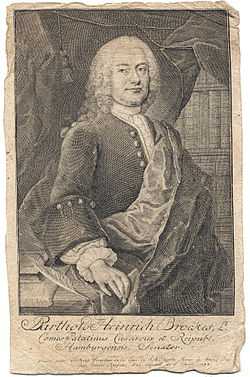
Barthold Heinrich Brockes, etching by Christian Fritzsch (1744)
-
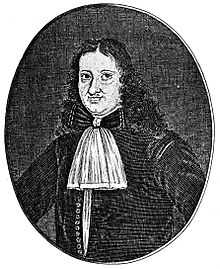
Christian Weise, etching by J.C. Böcklin
Scoring
The work is scored for vocal soloists, soprano, alto, tenor and bass, a four part choir SATB, and an orchestra of two flauto traverso (Ft), two oboes (Ob), two oboes da caccia (Oc), two violins, viola (Va), and basso continuo. Bach added some instruments in arias for special effects, old-fashioned already at the time, such as lute, viola d'amore and viola da gamba (Vg). Bach did not differentiate the vox Christi (voice of Christ), singing the words of Jesus, from the other bass recitatives and arias, nor the evangelist from the tenor arias.
Symmetry
The work displays a thoughtful symmetry. In the center of the five parts is the court hearing which confronts Jesus, Pilate and the people. In the middle of the hearing, a chorale (22) interrupts the argument, which talks about prison and freedom. It is surrounded by two choral movements, which not only both ask for the crucifixion of Jesus, but also use the same musical motifs, the second time intensified. Again in symmetry of similar musical material, a preceding turba choir explains the law, while a corresponding movement reminds Pilate of the emperor whose authority is challenged by someone calling himself a king. Preceding this, Jesus is greeted in mockery as the king, corresponding in motif to the later request that Pilate should change the inscription saying he is the king to that he claimed to be king.[8]
Versions
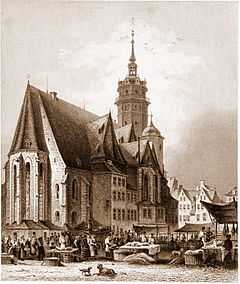
Bach led the first performance on 7 April 1724[9] at the Nikolaikirche (St. Nicholas)[10] as part of a Vesper service on Good Friday. Part I was performed before the sermon, Part II after the sermon.[10] Bach performed a second version on Good Friday a year later, 30 March 1725.[11] Other changes date from between 1728 and 1732 (version 3),[9] and between 1738 and 1748 (version 4).[12]
In version 2, Bach opened with a chorale fantasia on "O Mensch, bewein dein Sünde groß" (O man, bewail thy sins so great), the first stanza of a 1525 hymn by Sebald Heyden,[7] a movement which he ultimately used to conclude Part I of his St Matthew Passion, returning to the previous chorus Herr, unser Herrscher in later versions of the St John Passion. He used three alternative arias, one of them with a chorale sung by the choir, and replaced the two closing movements, the chorus "Ruht wohl" and the chorale "Ach Herr, laß dein lieb Engelein" with the chorale 'Christe, du Lamm Gottes" (O Christ, Lamb of God thou),[10] the German Agnus Dei, published in Braunschweig in 1528.[7] Bach took this movement from his cantata Du wahrer Gott und Davids Sohn, BWV 23, which had been an audition piece for the Leipzig post.[10]
In version 3, after Bach wrote his St Matthew Passion, he returned the opening chorus Herr, unser Herrscher and the final chorus "Ruht wohl" to their first position, but eliminated the Gospel passages after Matthew and the closing chorale.[10]
In version 4, Bach returned to the first version, possibly in 1739, but revised it thoroughly. He began a new score which covers 12 movements. As Christoph Wolff observes: "The fragmentary revised score constitutes an extensive stylistic overhaul with painstaking improvements to the part-writing and a partial restructuring of the instrumentation; particular attention was paid to the word-setting in the recitatives and the continuo accompaniment."[13] In 1749, Bach performed the St John Passion once more, to become his last performance of a Passion.[13]
Wolff writes: "Bach experimented with the St John Passion as he did with no other large-scale composition",[10] possible by the work's structure with the Gospel text as its backbone and interspersed features that could be exchanged.[10] Wolff concludes: "the work accompanied Bach right from his first year as Kantor of St Thomas's to the penultimate year of his life and thus, for that reason alone, how close it must have been to his heart.[14]
Tables of movements
The following tables give an overview of version I of the Passion, first performed in 1724. Two versions of movement numbers are given, first that of the Neue Bach-Ausgabe (NBA), then that of the older Bach-Werke-Verzeichnis (BWV). Voices appear in one of three columns, depending on the text source, Bible, contemporary poetic reflection, and chorale. The instrumentation is added, using abbreviations for instruments, followed by key and time signature, and the NBA number of a corresponding movement within the work's symmetry.
Part I
| NBA | BWV | Bible | Reflection | Chorale | Beginning of text | Source | Instruments | Key | Time | Symmetry | |
|---|---|---|---|---|---|---|---|---|---|---|---|
| 1 | 1 | Chorus | Herr, unser Herrscher | anonymous | 2Ft 2Ob 2Vn Va Bc | G minor | | 39 | |||
| 2 | a | 2 | Ev, Jesus | Jesus ging mit seinen Jüngern | John 18:1–8 | Bc | |||||
| b | 3 | Chorus | Jesum von Nazareth | 2Ft 2Ob 2Vn Va Bc | |||||||
| c | 4 | Ev, Jesus | Jesus spricht zu ihnen | Bc | |||||||
| d | 5 | Chorus | Jesum von Nazareth | 2Ft 2Ob 2Vn Va Bc | |||||||
| e | 6 | Ev, Jesus | Jesus antwortete | Bc | |||||||
| 3 | 7 | Chorus | O große Lieb | Johann Heermann | 2Ft 2Ob 2Vn Va Bc | G minor | | ||||
| 4 | 8 | Ev, Jesus | Auf daß das Wort erfüllet würde | John 18:9–11 | Bc | ||||||
| 5 | 9 | Chorus | Dein Will gescheh | Martin Luther | 2Ft 2Ob 2Vn Va Bc | F major | | ||||
| 6 | 10 | Ev, Jesus | Die Schar aber und der Oberhauptmann | John 18:12–14 | Bc | ||||||
| 7 | 11 | Alto | Von den Stricken meiner Sünden | Brockes | 2Ob Bc | D minor | 3/4 | ||||
| 8 | 12 | Ev | Simon Petrus aber folgete Jesu nach | John 18:15a | Bc | ||||||
| 9 | 13 | Soprano | Ich folge dir gleichfalls | anonymous | 2Ft Bc | B-flat major | 3/8 | ||||
| 10 | 14 | Ev et al. | Derselbige Jünger war dem Hohenpriester bekannt | John 18:15b–23 | Bc | ||||||
| 11 | 15 | Chorus | Wer hat dich so geschlagen | Paul Gerhardt | 2Ft 2Ob 2Vn Va Bc | A major | | ||||
| 12 | a | 16 | Ev | Und Hannas sandte ihn gebunden | John 18:24–27 Matthew 26:75 | Bc | |||||
| b | 17 | Chorus | Bist du nicht seiner Jünger einer | 2Ft 2Ob 2Vn Va Bc | |||||||
| c | 18 | Ev et al. | Er leugnete aber und sprach | Bc | |||||||
| 13 | 19 | Tenor | Ach, mein Sinn | Christian Weise | 2Vn Va Bc | F-sharp minor | | ||||
| 14 | 20 | Chorus | Petrus, der nicht denkt zurück | Paul Stockmann | 2Ft 2Ob 2Vn Va Bc | A major | | 15 | |||
Part II
| NBA | BWV | Bible | Reflection | Chorale | Beginning of text | Source | Instruments | Key | Time | Symmetry | |
|---|---|---|---|---|---|---|---|---|---|---|---|
| 15 | 21 | Chorus | Christus, der uns selig macht | Michael Weiße | 2Ft 2Ob 2Vn Va Bc | E | | 14 | |||
| 16 | a | 22 | Ev, Pilate | Da führeten sie Jesum | John 18:28–36 | Bc | |||||
| b | 23 | Chorus | Wäre dieser nicht ein Übeltäter | 2Ft 2Ob 2Vn Va Bc | |||||||
| c | 24 | Ev, Pilate | Da sprach Pilatus zu ihnen | Bc | |||||||
| d | 25 | Chorus | Wir dürfen niemand töten | 2Ft 2Ob 2Vn Va Bc | |||||||
| e | 26 | Ev, Pilate, Jesus | Auf daß erfüllet würde das Wort | Bc | |||||||
| 17 | 27 | Chorus | Ach großer König | Johann Heermann | 2Ft 2Ob 2Vn Va Bc | A minor | | ||||
| 18 | a | 28 | Ev, Pilate, Jesus | Da sprach Pilatus zu ihm | John 18:37–40 | Bc | |||||
| b | 29 | Chorus | Nicht diesen, sondern Barrabam | 2Ft 2Ob 2Vn Va Bc | |||||||
| c | 30 | Ev | Barrabas aber war ein Mörder | Bc | |||||||
| 19 | 31 | Arioso bass | Betrachte, meine Seel | Brockes Christian Heinrich Postel | 2 violas d'amore Bc with lute | ||||||
| 20 | 32 | Aria tenor | Erwäge, wie sein blutgefärbter Rücken | Brockes | 2 violas d'amore Bc | E-flat major | 12/8 | ||||
| 21 | a | 33 | Ev | Und die Kriegsknechte flochten eine Krone | John 19:1–12a | Bc | |||||
| b | 34 | Chorus | Sei gegrüßet, lieber Jüdenkönig | 2Ft 2Ob 2Vn Va Bc | 25 b | ||||||
| c | 35 | Ev, Pilate | Und gaben ihm Backenstreiche | Bc | |||||||
| d | 36 | Chorus | Kreuzige, kreuzige | 2Ft 2Ob 2Vn Va Bc | 23 d | ||||||
| e | 37 | Ev, Pilate | Pilatus sprach zu ihnen | Bc | |||||||
| f | 38 | Chorus | Wir haben ein Gesetz | 2Ft 2Ob 2Vn Va Bc | 23 b | ||||||
| g | 39 | Ev, Pilate, Jesus | Da Pilatus das Wort hörete | Bc | 23 a | ||||||
| 22 | 40 | Chorus | Durch dein Gefängnis, Gottes Sohn | Christian Heinrich Postel | 2Ft 2Ob 2Vn Va Bc | E major | | center | |||
| 23 | a | 41 | Ev | Die Jüden aber schrieen und sprachen | John 19:12b–17 | Bc | 21 g | ||||
| b | 42 | Chorus | Lässest du diesen los | 2Ft 2Ob 2Vn Va Bc | 21 f | ||||||
| c | 43 | Ev, Pilate | Da Pilatus das Wort hörete | Bc | |||||||
| d | 44 | Chorus | Weg, weg mit dem | 2Ft 2Ob 2Vn Va Bc | 21 d | ||||||
| e | 45 | Ev, Pilate | Spricht Pilatus zu ihnen | Bc | |||||||
| f | 46 | Chorus | Wir haben keinen König | 2Ft 2Ob 2Vn Va Bc | |||||||
| g | 47 | Ev | Da überantwortete er ihn | Bc | |||||||
| 24 | 48 | Aria bass and chorus | Eilt, ihr angefochtnen Seelen | Brockes | 2Vn Va Bc | G minor | 3/8 | ||||
| 25 | a | 49 | Ev | Allda kreuzigten sie ihn | John 19:18–22 | Bc | |||||
| b | 50 | Chorus | Schreibe nicht: der Jüden König | 2Ft 2Ob 2Vn Va Bc | 21 b | ||||||
| c | 51 | Ev, Pilate | Pilatus antwortet | Bc | |||||||
| 26 | 52 | Chorus | In meines Herzens Grunde | Valerius Herberger | 2Ft 2Ob 2Vn Va Bc | E-flat major | | ||||
| 27 | a | 53 | Ev | Die Kriegsknechte aber | John 19:23–27a | Bc | |||||
| b | 54 | Chorus | Lasset uns den nicht zerteilen | 2Ft 2Ob 2Vn Va Bc | |||||||
| c | 55 | Ev | Auf daß erfüllet würde die Schrift | Bc | |||||||
| 28 | 56 | Chorus | Er nahm alles wohl in acht | Paul Stockmann | 2Ft 2Ob 2Vn Va Bc | A major | | ||||
| 29 | 57 | Ev, Jesus | Und von Stund an nahm sie der Jünger | John 19:27b–30a | Bc | ||||||
| 30 | 58 | Aria alto | Es ist vollbracht | Christian Heinrich Postel | Vg 2Vn Va Bc | B minor D major | 3/4 | ||||
| 31 | 59 | Ev | Und neiget das Haupt | John 19:30b | Bc | ||||||
| 32 | 60 | Aria bass | Chorus | Mein teurer Heiland, laß dich fragen | Brockes Paul Stockmann | 2Vn Va Bc | D major | 12/8 | |||
| 33 | 61 | Ev | Und siehe da, der Vorhang im Tempel zerriß | Matthew 27:51–52 | Bc | ||||||
| 34 | 62 | Arioso tenor | Mein Herz, in dem die ganze Welt | Brockes | 2Ft 2Oc 2Vn Va Bc | ||||||
| 35 | 63 | Aria soprano | Zerfließe, mein Herze | Brockes | Ft Oc Bc | F minor | 3/8 | ||||
| 36 | 64 | Ev | Die Jüden aber, dieweil es der Rüsttag war | John 19:31–37 | Bc | ||||||
| 37 | 65 | Chorus | O hilf, Christe, Gottes Sohn | Michael Weiße | 2Ft 2Ob 2Vn Va Bc | F minor | | ||||
| 38 | 66 | Ev | Darnach bat Pilatum Joseph von Arimathia | John 19:38–42 | Bc | ||||||
| 39 | 67 | Chorus | Ruht wohl, ihr heiligen Gebeine | Brockes | 2Ft 2Ob 2Vn Va Bc | C minor | 3/4 | ||||
| 40 | 68 | Chorus | Ach Herr, laß dein lieb Engelein | Martin Schalling | 2Ft 2Ob 2Vn Va Bc | E-flat major | | ||||
Overview
In the following, the movement numbers are those of the NBA, version I, unless otherwise noted.
The chorales in detail
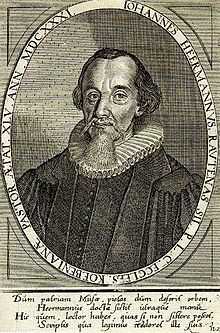
The first chorale, movement 3, is inserted after Jesus said to arrest him, but let the disciples go. "O große Lieb, o Lieb ohn alle Maße" (O mighty love, O love beyond all measure)[7] is stanza 7 of Johann Heermann's 1630 hymn "Herzliebster Jesu, was hast du verbrochen". In personal reflection, the speaker sees the contrast of his pleasure in the world and the suffering of Jesus, ending in a short "Und du mußt leiden" (And thou must suffer).[7]
.jpg)
The second chorale, movement 5, ends the first scene (of the arrest), after Jesus remarks that he has to be obedient. "Dein Will gescheh, Herr Gott, zugleich" (Thy will be done, Lord God, alike)[7] is stanza 4 of Luther's 1539 hymn "Vater unser im Himmelreich,[7] a paraphrase of the Lord's Prayer.
The third chorale, movement 11, is inserted after Jesus asks the one who beat him for justification. Two stanzas from Paul Gerhardt's 1647 hymn "O Welt, sieh hier dein Leben" comment the scene, stanza 3, "Wer hat dich so geschlagen" (Who hath thee now so stricken),[7] and stanza 4, "Ich, ich und meine Sünden" (I, I and my transgressions),[7] highlighting the personal responsibility of the speaking sinner for the suffering of Jesus.
The fourth chorale, movement 14, ends the second scene (of the arrest) and Part I. After the denial of Peter, "Petrus, der nicht denkt zurück" (Peter, when he fails to think)[7] summarizes the scene in stanza 10 of Paul Stockmann's 1633 hymn "Jesu Leiden, Pein und Tod".[7]
The fifth chorale, movement 15, opens Part II and the third scene (of the court hearing). "Christus, der uns selig macht" (Christ, who hath us blessed made),[7] stanza 1 of Michael Weiße's 1531 hymn, summarizes what Jesus has to endure although innocent ("made captive, ... falsely indicted, and mocked and scorned and bespat").[7]
The sixth chorale, movement 17, comments in two more stanzas from "Herzliebster Jesu" (3), after Jesus addressed the different kind of his kingdom. Stanza 8, "Ach großer König, groß zu allen Zeiten" (Ah King so mighty, mighty in all ages)[7] reflects the kingdom and the need for thanksgiving, stanza 9 the inability to grasp it, "Ich kanns mit meinen Sinnen nicht erreichen" (I cannot with my reason ever fathom).[7]
The seventh chorale, movement 22, is the central movement of the whole Passion, which interrupts the conversation of Pilate and the crowd by a general statement of the importance of the passion for salvation: "Durch dein Gefängnis, Gottes Sohn, ist uns die Freiheit kommen" (Through this thy prison, Son of God, must come to us our freedom)[7] is not part of a known hymn, but the text of an aria from a St John Passion by Postel from c. 1700.[7]
The seventh chorale, movement 26, ends the scene of the court hearing, after Pilate refuses to change the inscription. "In meines Herzens Grunde" (Within my heart's foundation)[7] is stanza 3 of Valerius Herberger's 1613 hymn "Valet will ich dir geben".[7]
The eighth chorale, movement 28, is related to Jesus telling his mother and John to take care of each other. "Er nahm alles wohl in acht" (He of all did well take heed)[7] is stanza 20 of Stockmann's hymn (14).[7]
The ninth chorale, movement 32, is part of the bass aria which follows immediately after the report of the death of Jesus. "Jesu, der du warest tot, lebest nun ohn' Ende" (Jesus, thou who suffered death, livest now forever)[7] is the final stanza of Stockmann's hymn (14).[7]
The tenth chorale, movement 37, ends the scene of the crucifixion. "O hilf, Christ, Gottes Sohn" (O help, Christ, O Son of God)[7] is stanza 8 of Weiße's hymn (15).[7]
The eleventh chorale, movement 40, ends the Passion. "Ach Herr, laß dein lieb Engelein" (Ah Lord, let thine own angels dear)[7] is stanza 3 of Martin Schalling's 1569 hymn "Herzlich lieb hab ich dich, o Herr".[7]
References
- ↑ Chafe 1989, p. 75.
- ↑ 2.0 2.1 Johnston 2014.
- ↑ Laffin 2007, p. 53.
- ↑ Dürr 1999, p. 66.
- ↑ Dürr 1999, p. 54.
- ↑ Steinberg 2005, p. 18.
- ↑ 7.0 7.1 7.2 7.3 7.4 7.5 7.6 7.7 7.8 7.9 7.10 7.11 7.12 7.13 7.14 7.15 7.16 7.17 7.18 7.19 7.20 7.21 7.22 7.23 7.24 7.25 7.26 Ambrose 2012.
- ↑ Wong 2004.
- ↑ 9.0 9.1 Bach digital 1 1973.
- ↑ 10.0 10.1 10.2 10.3 10.4 10.5 10.6 Wolff 2012, p. 3.
- ↑ Bach digital 2 1973.
- ↑ Bach digital 4 1973.
- ↑ 13.0 13.1 Wolff 2012, p. 4.
- ↑ Wolff 2012, p. 2.
Sources
Scores
- Johannespassion: Scores at the International Music Score Library Project
- "St. John passion (first version) BWV 245; BC D 2a". Leipzig University. 1973. Retrieved 29 March 2014.
- "St. John passion (second version) BWV 245; BC D 2b". Leipzig University. 1973. Retrieved 29 March 2014.
- "St. John passion (third version) BWV 245; BC D 2c". Leipzig University. 1973. Retrieved 29 March 2014.
- "St. John passion (fourth version) BWV 245; BC D 2d, 2e". Leipzig University. 1973. Retrieved 29 March 2014.
- "Johannespassion, BWV 245 (Johann Sebastian Bach)". CPDL Free Choral Sheet Music. Retrieved 29 March 2014.
Books
- Chafe, Eric T. (1989). Franklin, Don O., ed. The St John Passion: theology and musical structure, in: Bach Studies, Volume 1. CUP Archive. ISBN 0-52-134105-1.
- Dürr, Alfred (1999). Johann Sebastian Bach, Die Johannes-Passion / Entstehung, Überlieferung, Werkeinführung (in German). Bärenreiter. ISBN 3-7618-1473-9.
- Scholz, Gottfried (2000). Bachs Passionen: ein musikalischer Werkführer (in German). C.H.Beck. ISBN 3-406-43305-7.
- Steinberg, Michael (2005). Saint John Passion, in:Choral Masterworks: A Listener's Guide. Oxford University Press. ISBN 0-19-802921-7.
Online sources
- Ambrose, Z. Philip (2012). "BWV 245 Johannes-Passion". University of Vermont. Retrieved 29 March 2014.
- Bach, Peter. "Johannes-Passion" (in German). bach.de. Retrieved 29 March 2014.
- Bischof, Walter F. (2012). "BWV 245 Johannes-Passion". University of Alberta. Retrieved 29 March 2014.
- Braatz, Thomas; Oron, Aryeh (2006). "Chorale Melodies used in Bach's Vocal Works / Machs mit mir, Gott, nach deiner Güt". bach-cantatas.com. Retrieved 29 March 2014.
- Browne, Francis (2006). "Durch dein Gefängnis, Gottes Sohn / Text and Translation of Chorale". bach-cantatas.com. Retrieved 29 March 2014.
- Gardiner, John Eliot (2011). "Bach's first Leipzig Passion" (PDF). bach-cantatas.com. Retrieved 29 March 2014.
- Hoffman, William (2010). "Literary Origins of Bach's St. John Passion: 1704–1717". bach-cantatas.com. Retrieved 5 April 2014.
- Johnston, Blair (2014). "Johann Sebastian Bach / St. John Passion (Johannespassion), BWV 245 (BC D2)". Allmusic. Retrieved 29 March 2014.
- Kolb, Gerhard. "Die Passionsgeschichte vom Leiden und Sterben Jesu Christi in der musikalischen Interpretation von J.S. Bach" (in German). ISBN 3-406-43305-7.
- Laffin, Frank (2007). "J. S. Bach: Johannes-Passion – Eine musikalische Analyse" (PDF) (in German). gemeindemusikschule.de.
- Oron, Aryeh (2011). "Johannes-Passion BWV 245". bach-cantatas. Retrieved 29 March 2014.
- Clüsserath, Tilla (2013). "Johann Sebastian Bach / Johannespassion" (PDF) (in German). Kölner Philharmonie. Retrieved 29 March 2014.
- Wolff, Christoph (2012). "Bach: St John Passion" (PDF). Hyperion Records. Retrieved 29 March 2014.
- Wong, Audrey (2004). "St. John Passion". bach-cantatas.com. Retrieved 12 April 2014.
- "BWV 245 – Passio secundum Johanneum / St. John Passion". en.bachdb.com. Retrieved 31 March 2014.
- "Die Johannes-Passion von Johann Sebastian Bach" (in German). emmaus.de. Retrieved 31 March 2014.
| ||||||||||||||||||||||||||||||
